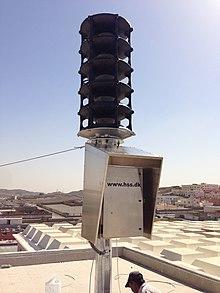An early warning system can be implemented as a chain of information communication systems and comprises sensors, event detection and decision subsystems. They work together to forecast and signal disturbances that adversely affect the stability of the physical world, providing time for the response system to prepare for the adverse event and to minimize its impact.[1]

To be effective, early warning systems need to actively involve the communities at risk, facilitate public education and awareness of risks, effectively disseminate alerts, and warnings and ensure there is constant state of preparedness.[2] A complete and effective early warning system supports four main functions: risk analysis, monitoring and warning; dissemination and communication; and a response capability.[3]
Application
Risk analysis involves systematically collecting data and undertaking risk assessments of predefined hazards and vulnerabilities. Monitoring and warning involves a study of the factors that indicate a disaster is imminent, as well as the methods used to detect these factors. Dissemination and communication concerns communicating the risk information and warnings to reach those in danger in a way that is clear and understandable. Finally, an adequate response capability requires the building of national and community response plan, testing of the plan, and the promotion of readiness to ensure that people know how to respond to warnings.
An early warning system is more than a warning system, which is simply a means by which an alert can be disseminated to the public.
History
Since the Indian Ocean tsunami of 26 December 2004, there has been a surge of interest in developing early warning systems.[4][5] However, early warning systems can be used to detect a wide range of events, such as vehicular collisions, missile launches, disease outbreaks, and so forth. See warning system for a wider list of applications that also can be supported by early warning systems.
References
- ^ Waidyanatha, Nuwan (2010). "Towards a typology of integrated functional early warning systems". International Journal of Critical Infrastructures. No 1. 6: 31–51. doi:10.1504/ijcis.2010.029575. Retrieved 3 August 2012.
- ^ Wiltshire, Alison (2006). Developing Early Warning Systems: A Checklist (PDF). Proceedings of the 3rd International Conference on Early Warning EWC III, Bonn (Germany).
- ^ "Basics of early warning". Retrieved 2014-08-07.
- ^ Basher, Reid (15 August 2006). "Global early warning systems for natural hazards: systematic and people-centered". Philosophical Transactions of the Royal Society. 364 (1845): 2167–2182. Bibcode:2006RSPTA.364.2167B. doi:10.1098/rsta.2006.1819. PMID 16844654.
- ^ "Japan provides early warning example". UN World Conference on Disaster Risk Reduction. 15 Mar 2015.
